- All Posts
- /
- Why Product Hunt’s Emails Are So Addictive

Why Product Hunt’s Emails Are So Addictive
News and Updates-
 Jimmy Daly
Jimmy Daly
-
Updated:Posted:
On this page
I’ve got a fever and the only prescription is more Product Hunt.
If you aren’t familiar with Ryan Hoover’s addictive product discovery site, it’s time you check it out. Here’s how it works:
- Select users submit products like apps, books and startups
- The community votes and comments on them
- Each morning, Product Hunt sends an email with the best products of the previous day
It’s a simple idea but it’s grown into an active and influential community. According to The Verge, “Traffic to Product Hunt has grown 50 percent every month since January, and each month it drives 2 million visits to the products featured on its leaderboard.”
The product is great and the story is even better. Product Hunt began as a simple email list. Hoover was collecting cool products he found around the web and using a tool called LinkyDink to send them around to a few friends. Interest grew, more friends joined and soon, Hoover realized he was onto something special.
As Hoover told First Round Review, email is still fundamental to the site’s success:
“Even though the email was super basic, it gave me validation that people cared about this content,” says Hoover. And when he eventually decided to build the site, the email list became the most important asset and springboard for driving traffic and keeping people coming back again and again. It’s continued to swell as Product Hunt has gained momentum, a constant source of new fans and marketing opportunities.
As of September 2014, Product Hunt had more than 70,000 email subscribers and a $6 million funding round from Andreessen Horowitz.
There are ton of great articles about Product Hunt but this one will focus on their email strategy. For more reading, check out the following links:
- First Round Review: Product Hunt is Everywhere – This is How It Got There
- Ryan Hoover’s Personal Blog: Email-First Startups
Now, let’s start dissecting the reasons Product Hunt’s emails are so addictive.
To receive them, sign up for a Product Hunt account and you’ll be added to the daily email list.
1. They are habit-forming.
Ryan Hoover contributed to Nir Eyal’s book Hooked which is all about building habit-forming products. Hoover is well-versed in the psychology of habits, which is why we can be sure Product Hunt’s decision to send daily emails is intended to create a daily habit.
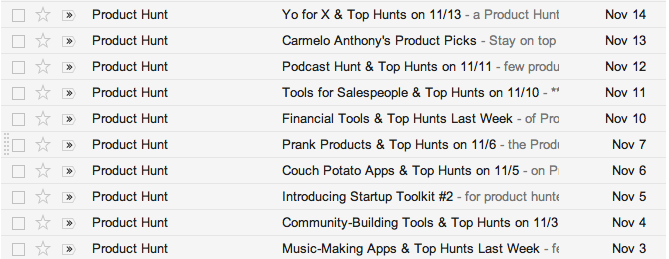
As Eyal writes on his blog, frequency is key to developing new habits:
When it comes to forming habits, frequency matters and studies have demonstrated that how often a behavior occurs is a key factor in the likelihood of creating a new routine.
Engineered correctly, a daily email newsletter can actually elicit a dopamine rush for the recipient. For Product Hunt, the email soothes the anxiety of FOMO (fear of missing out). There are always new products and for the right user, there’s always another burst of dopamine waiting to be released.
2. They are always fresh.
The Product Hunt newsletter contains at least five new products every single day. It’s an aggressive pace to maintain but, by doing so, Hoover ensures that every email contains something new and interesting. It’s not the same content from yesterday or any previous email, so you have to open it to find out what’s new.
They have even built language into the emails that remind the recipient that the products are fresh and won’t be for long. The email header, for example, reminds that recipient that these are actually yesterday’s products. They are recent but they’ll be old news by tomorrow.

They use similar language in the body of the email:
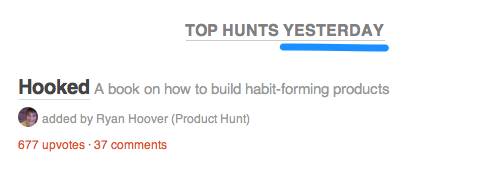
The steady stream of new content keeps everyone interested. And because it’s daily, Product Hunt can quickly weed out uninterested users, helping them maintain super high engagement with their emails.
3. They use social proof.
One key reason that Product Hunt emails work so well is because the content has already been validated. By including the products that got the most votes on the site, they can nearly guarantee that the content will also resonate with their email readers. This is social proof at work.
Here’s a quick definition from Ed Hallen:
What is social proof?
Social proof is the concept that people will conform to the actions of others under the assumption that those actions are reflective of the correct behavior.
Product Hunt builds social proof directly into their emails by showing how many votes and comments each product has. The more votes and comments, the more validation and the more people feel like they are missing out if they don’t join in.
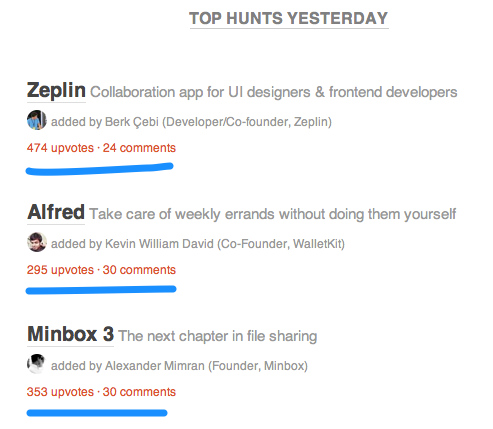
Check out our email best practices guide (tip #4) to see how other companies are using social proof in their email.
4. They include a daily surprise.
Frequency and repetition are fundamental to creating habit-forming behavior but a little bit of serendipity doesn’t hurt either. Product Hunt accomplishes this in two ways. First, the products in every email are new and fresh. That alone keep users interested. But they also include a short editorial bit at the beginning of each email to provide additional incentive to open and click.
At the top of every email, Product Hunt includes a brief, original editorial section that may promote a new podcast, link to a collection of products in a particular category, or make an announcement (like its inclusion in YC). “It’s intended to be different and unexpected, and I think that’s one of the main reasons people open it up, especially our hardcore fans who don’t care very much about the top five. They still want to know what is new, and that drives action.”
This keeps the emails interesting. Here are a few recent examples:
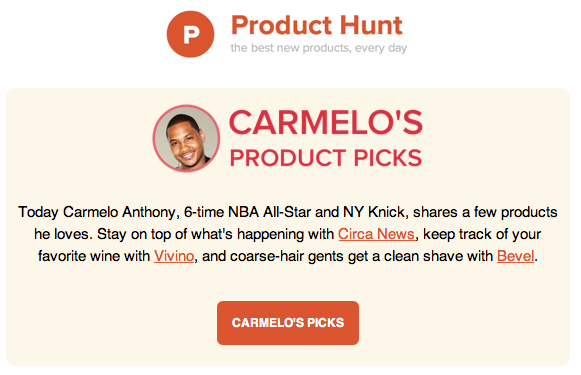
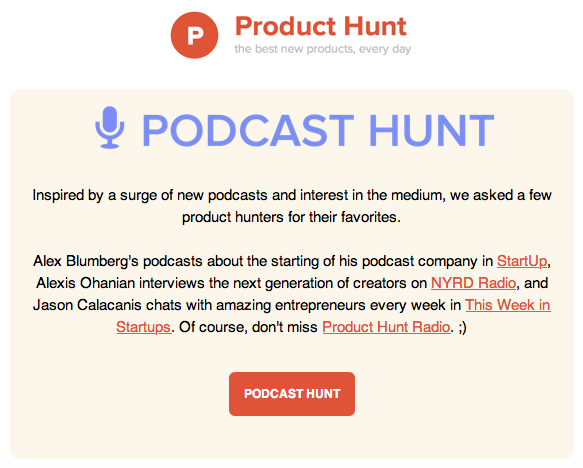
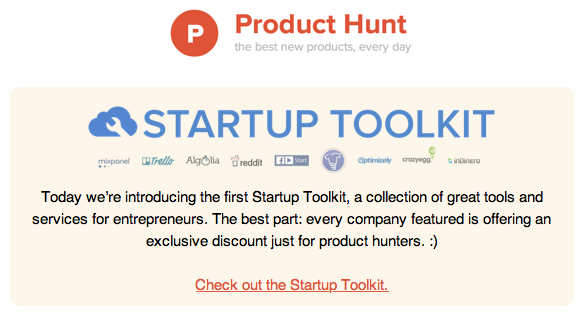
If you haven’t already, go sign up to see these emails in action.
What lessons can you apply to your own email marketing? Drop a note in the comments.

